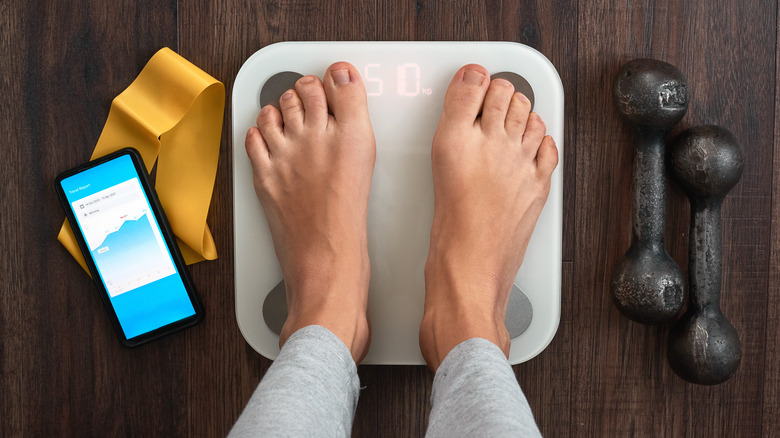Water Weight Versus Fat: How To Tell The Difference
Stepping on the scale is a routine part of any weight management plan. Seeing a drop in the numbers on the scale can be a great boost for your morale and motivation, but it's possible that the drop is only temporary. In fact, for many individuals, the first few weeks after starting a new diet or workout routine, the pounds seem to just melt away, like the sweat left behind on the gym floor. But as with many things, this weight loss may be too good to be true, at least in the long run (via Livestrong). For those who've been on the diet train before, a fluctuating scale may be part of the normal routine, but understanding why your scale numbers seem to be on a rollercoaster can help to create a more successful plan overall.
According to Healthline, over 50% of an individual's body weight is due to water, though the percentages vary across age and gender. So just how does this water weight factor into your overall weight management plans? And how can you determine if those pounds lost are water or fat?
What is water weight?
The term water weight is used to describe the weight experienced when the body is holding onto, or retaining, excess water. According to Insider, water retention is when water is stored in the tissues or between the blood vessels.
There are a number of causes for water retention including certain medical conditions, dehydration, excessive consumption of sodium or carbohydrates, hormone fluctuations, or even the weather. There are also a number of life events and activities, such as flying in an airplane, which can increase the risk of water retention (via Healthline).
According to LiveStrong, a diet high in carbohydrates causes the body to store glycogen, a source of energy for the body. Glycogen can hold up to three times its weight in water, which can create the numbers on the scale to reflect a higher body weight. It can also give the body a bloated appearance (via Insider). However, when the body uses stored glycogen, any retained water is also shed, through sweat or urination. The effects can be long-term if a balanced diet and workout regime are maintained. However, excessive consumption of carbohydrates will replenish glycogen stores in the body, and increase the capacity for "water weight" (via Livestrong).
How do I know if it's water weight or fat?
A healthy diet and exercise plan may initially show dramatic decreases on the scale but will usually taper off after a few weeks, according to Livestrong. On average, most healthy weight loss plans allow for one to two pounds of total weight loss each week.
Larger losses are more often associated with water weight and are usually not permanent. Fat loss occurs much more slowly but with consistency, the effects are manageable for long-term success.
According to Insider, there are a few ways to determine if you are carrying extra water weight. First, if you notice swelling around your wrists or ankles, this is typically an indication that you're most likely holding water weight (via Medical News Today). Another sign is if you press into your skin and the indentation stays for a few seconds, it is most likely that you are retaining water. Body weight from fat is more likely to take longer to accumulate and thus is much slower in coming off. So when stepping on the scale to chart your weight management plan, be sure to keep in mind that factors like excessive sodium or carbohydrates can cause water weight, which will reflect on the scale.



